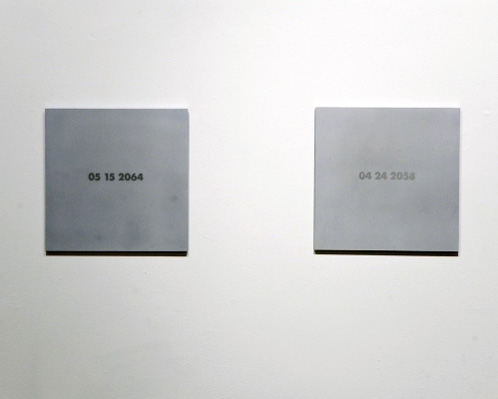I cannot figure out what to do with the artwork of Caleb Larsen. We have seen the mutilating world of scarification. We have swallowed hard the brutal images brought to us through the Event Horizon art display. But what to do with this — the kind of art work which doesn’t so much challenge your ideas or push your imagination so much as make you wonder why it is in a museum in the first place. Let us first look at the work titled “The Day The Internet Told Us We Would Die.” The entire work consists of printouts of two dates — the date that a web site calculated that the artist would die, and the date that the site calculated that his wife would die. Two pieces of paper with printed death dates from a death date web site.

Next, let us turn to The Complete Works of Shakespeare. Here is one which I can somewhat get behind, because it is based on the works of Shakespeare. Really, though, there is no way a person would know that this is the case just by looking at the work as it consists entirely of color dots that each represents a letter. It just as well could have been a completely random arrangement of twenty-six color dots.
A Tool to Deceive and Slaughter could be one of the most intriguing works I have ever seen displayed online, only by its nature to continually try to sell itself.
Every ten minutes the black box pings a server on the internet via the ethernet connection to check if it is for sale on the eBay. If its auction has ended or it has sold, it automatically creates a new auction of itself.
If a person buys it on eBay, the current owner is required to send it to the new owner. The new owner must then plug it into ethernet, and the cycle repeats itself.
In short, it is impossible to ever really own it. I suppose from this we can learn that one might think that one owns something, but one never really owns anything due to the transitory nature of our existence. It is a significant life lesson. Nevertheless, so few of the works of art by Caleb Larsen impart such a lesson.
The worst example of such an artwork is the Ten Thousand Dollar Sculpture (in progress) that is nothing but a dollar bill collector in the wall.
This device has become a symbol of self-serve retail transactions. In this instance, it is installed seamlessly into a plain white wall with no clues to inform the viewer as to the nature of the piece. Nor does it suggest what might happen if they were to insert a dollar bill.
As it turns out, what happens is that the money is gathered until ten thousand dollars is accumulated, and then it is split half-half between the owner of the museum and Caleb Larsen. The experiment then repeats ad infinitum. I understand that art does not pay for itself to get made but this may be taking that idea a little too far.
What can we learn from the art of Caleb Larsen? Is it possible that art can just hang in a museum without having a meaning or a reason to be there? Perhaps we are meant to provide the meaning for art when it is not entirely obvious to us.
I’m calling baloney on Caleb Larsen, Gordon! You are much kinder to his expressionistic b.s. than I would’ve been. This is pretentious art that mocks the innocent observer by being “too cute” and eternally obtuse. Pass.
Good call, David! Reminds me of high school artwork where you see it and think, uhm… huh?
It is incredibly silly, Gordon, and the money machine and eternal eBay machine make it clear the joke is on us.